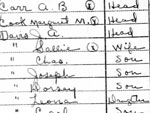BROWSE BY CATEGORY
- Archives and Libraries
- Blogs and Networking
- Bookmark This
- Digital Tools
- Examples of Teaching
- Exhibits
- Film Reviews
- History and Headlines
- Historic Sites and Museums
- Historical Thinking
- Holidays and Heritage
- Issues and Research
- Lesson Plans
- Material and Visual Culture
- Multimedia
- Organizations and Agencies
- Primary Sources
- Professional Development
- Publications
- Student Activities
- Teaching Materials
- Websites
Family History and the 1940 Census

On April 2, 2012, the U.S. National Archives released detailed 1940 census records offering full access to 1940 census images as well as 1940 census maps and descriptions. I am enhancing my knowledge base on my family's history by using the information gathered in the April 1940 Census.
Each detailed census, released after 72 years, covers important data about most families. The release consists primarily of the actual census data sheets filled out by the enumerator or census-taker that contain information on addresses, family members, ages, sex, race, marital status, educational attainment, birthplace, and occupation. The occupation category reports on the wages earned. There is a subcategory which includes those who performed "Public Emergency Work." This subcategory chronicles the situation of over three million people who worked for such New Deal agencies as the Civilian Conservation Corps, the Works Progress Administration, and the National Youth Administration which employed unemployed people to carry out specific work projects during the depths of the Great Depression. There is also a category that directed the Enumerator to "indicate whether engaged in home housework (H), in school (S) unable to work (U), or other (Ot)."
In order to find information about my grandparents and great-grandparents, I used the census maps of Enumeration Districts provided by Stephen Morse and Joel Weintraub at the Unified 1940 Census ED Finder. I started by looking for Enumeration District maps that covered the area where my family members lived. Then I searched the data sheets in each district until I found actual addresses for my relatives and could complete my search. Most people do not know their relatives' addresses and may choose to look under their names. While many companies offer research services (for a fee), the 1940 census data can be a wonderful resource for conducting your own research or learning about life in the 1940s.
The following organizations are organizing the digitized data sheets so that searches can be made by the name of the family member. Each contains some free information, as well as more complete information that requires a monthly or annual fee:
For more information
Searching census data can both answer and create questions. In an earlier blog entry, Alex Stein looks at his questions as he researched urban history.
Genealogy research projects reward students with a personal look into history. High school teacher Joe Jelen shares project ideas.
For earlier census data, try the University of Virginia's U.S. Historical Census Browser.
